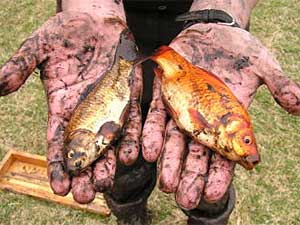|
Audio
Photos
Resources
Your Voice
|
Don't set Nemo free
May 13, 2004
 |
| These two goldfish were pulled out of a pond in Duluth. They started out as small aquarium goldfish. But when introduced into the wild, they can grow up to 10 or 16 inches. (MPR Photo/Chris Julin) |
Duluth, Minn. — Rock Pond is in a nature center across the street from the University of Minnesota, Duluth. Now, it's empty. Workers have drawn the water from the pond this week. What's left is a muddy basin, bigger than a couple football fields. There are a few puddles here and there.
Tyler Winter has been catching fish in the puddles. He's wearing hip waders, and he's covered in mud. He's carrying a five-gallon plastic bucket that's half-full of fish. After he studies the fish, they'll become garden compost.
"We got domestic goldfish, of various sizes and colors," Winter says as pulls a couple fish from the bucket. Each one is the size of his hand.
 | |||
"These actually started as little aquarium goldfish," he says. "This is the same kind of a thing that you would find at a pet store. But when introduced into the wild and they have more room to grow and they don't die quickly, they can grow up to 10 or 16 inches. I got one out of this pond that's probably a little over 10 inches."
Rock Pond flows into Tischer Creek, and Tischer Creek is a designated trout stream. Trout need clean water, but goldfish stir up muck from the bottom when they feed. Goldfish could pose a threat to the trout in Tischer Creek.
People frequently release goldfish, koi, and other aquarium fish, and Doug Jensen compares those fish to the common carp. Jensen is with Minnesota Sea Grant, one of the groups behind the draining of Rock Pond. Carp aren't native, but they've thrived in the wild, and now they live throughout the United States.
"That has been probably the most devastating non-native, exotic species of fish," Jensen says.
Carp, like goldfish, stir up the bottom and make the water less clear. Jensen says some aquarium fish pose other threats.
"Some of these species can hybridize with our native fish," Jensen says. "And they can also carry diseases which can be transferred to some of our native species."
 | |||
Jensen says people release a startling variety of animals and plants from their aquariums and backyard water gardens, and he says it's a bigger problem than most people realize. In the Great Lakes region alone, 38 species of animals and plants have reached the "infestation" level after being released into the wild from aquariums.
So Minnesota Sea Grant is trying to get people to stop releasing fish and plants. Sea Grant has joined with the U.S. Fish and Wildlife Service and companies that make and sell aquariums. They'll be performing projects like the pond-draining in Duluth, and they'll be launching a big public relations campaign across the country in coming months.
"What we're attempting to do is promote a 'don't release' message to aquarium owners and water garden owners," Jensen says.
Some aquarium makers have agreed to put "Don't Release" stickers on their aquariums. The same message will be printed on the plastic bags that people use to bring fish home from the store. The public relations campaign will try to convince people to donate their unwanted fish to someone else with an aquarium instead of turning the fish loose.
In Minnesota it's illegal to release aquatic plants or fish into the wild.
|
News Headlines
|
Related Subjects
|
